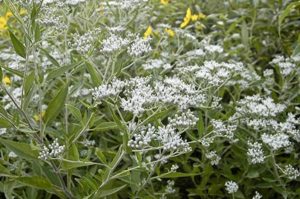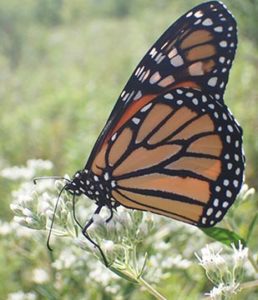Thoroughworts and bonesets (Eupatorium sp.) are common fall wildflowers throughout much of the eastern U.S. They are often found growing in fields and other open areas. Their flat-topped clusters of bright white flowers can contrast beautifully with the bright yellow goldenrods or the deep purple ironweeds that often grow in similar habitats.
Like the goldenrods, there are lots of different species of thoroughworts and bonesets. The USDA Plants Database lists approximately 25 species of Eupatorium (the thoroughwort and boneset genus) that are native to some part of the eastern U.S. Not all of these species are found throughout the entire eastern U.S., and some species are more common than others, but every eastern state has at least one species of native Eupatorium. (Note: Older references still list plants such as joe-pye weed, white snakeroot, and mistflower as being in the Eupatorium genus. However, more recent research has moved these plants into their own genera and the genus Eupatorium currently only contains the thoroughworts and bonesets.)

Frequently, the terms thoroughwort and boneset are used interchangeably either for the genus or for individual species. For example, tall boneset and tall thoroughwort both refer to Eupatorium altissimum. Other times, one term may be more commonly accepted as the “correct” common name, for example common boneset (Eupatorium perfoliatum), which is often just called boneset. Like their goldenrod cousins, many of the thoroughworts and bonesets look very similar and for general purposes, they are often lumped together and discussed at the genus level instead of the species level.
Whatever you want to call them, thoroughworts and bonesets are pollinator magnets. Butterflies, bees, wasps, and pollinating flies all love thoroughworts and bonesets. For these insects, thoroughworts and bonesets join the goldenrods, ironweeds, and fall blooming asters in providing an important late-season source of nectar and pollen. The plants are also host plants for the caterpillars of several species of moths.
Where I’m at in Kentucky, thoroughworts and bonesets typically start blooming in late July or early August and will continue to bloom through late September or early October. It’s not always the same species blooming for that entire time, but I can usually find at least one Eupatorium species blooming throughout that timeframe. The bloom times for your thoroughworts and bonesets may vary slightly depending on the exact species and where you are located, but you’ll likely have a similar, long bloom period that lasts through much, if not all, of the fall.

Thoroughworts and bonesets are fairly easy to grow in wildflower gardens. The species that more commonly have boneset in their name tend to like wetter habitats while the species more commonly referred to as thoroughworts tend to prefer drier habitats. However, as I noted before, sometimes the same species may commonly be referred to as either a boneset or a thoroughwort. So, use the name as a very general guideline that can often be broken.
Most of the thoroughworts and bonesets tend to be relatively tall plants so are best planted at the back of a wildflower garden where they won’t block shorter flowers. Mix them with goldenrods and ironweeds of similar heights for a pretty fall display that benefits a variety of pollinators.
However, be aware that they can be a little on the aggressive side, which is understandable considering that you often find them growing wild with goldenrods, ironweeds, and other species that can be somewhat aggressive in small spaces. Personally, I haven’t found them to be too bad as long as I plant them with other plants that have similar growth habits, but it is something to consider when planning your pollinator gardens.

Backyard Ecology: Exploring Nature in Your Backyard
Nature isn’t just “out there.” It’s all around us, including right outside our doors. Hi, my name is Shannon Trimboli, and I am the host of Backyard Ecology. I live in southcentral Kentucky and am a wildlife biologist, educator, author, beekeeper, and owner of a nursery specializing in plants for pollinators and wildlife conservation. I invite you to join me as we ignite our curiosity and natural wonder, explore our yards and communities, and improve our local pollinator and wildlife habitat. Learn more or subscribe to my email list at www.backyardecology.net.

Leave a Reply